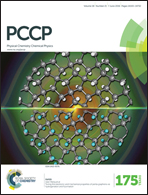A closer examination of the coupling between ionic hydrogen bond (IHB) stretching and flanking group motions in (CH3OH)2H+: the strong isotope effects†
Abstract
The intermode coupling between shared proton (O–H+–O) fundamental stretching and flanking modes in (CH3OH)2H+ was revisited in the following contexts: (1) evaluation of Hamiltonian matrix elements represented in a “pure state” (PS) basis and (2) tuning of coupling strengths using H/D isotopic substitution. We considered four experimentally accessible isotopologues for this study. These are: (CH3OH)2H+, (CD3OH)2H+, (CH3OD)2D+, and (CD3OD)2D+. Potential energy surfaces (PESs), as well as dipole moment surfaces (DMSs), were constructed at the MP2/aug-cc-pVDZ level. Multidimensional vibrational calculations were conducted by solving a reduced dimensional Schrödinger equation using a discrete variable representation (DVR). We found that vibrational states in (CH3OH)2H+ and (CD3OH)2H+ are much more heavily mixed than those in (CH3OD)2D+ and (CD3OD)2D+. Furthermore, each isotopologue chooses to strongly couple between out-of-phase in-plane CH3 rocking and its out-of-plane counterpart. Lastly, the interaction between O–O stretching and O–H+–O stretching was explored. We found that between the first overtone of O–O stretching and its combination tone with O–H+–O fundamental stretching, only the second couples with O–H+–O fundamental stretching. We hope that our isotopologue calculations would motivate experimentalists to measure them in the future.


 Please wait while we load your content...
Please wait while we load your content...